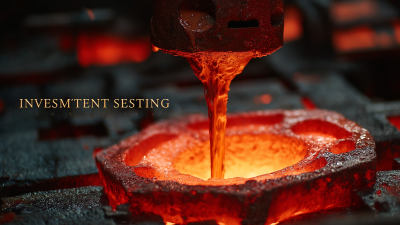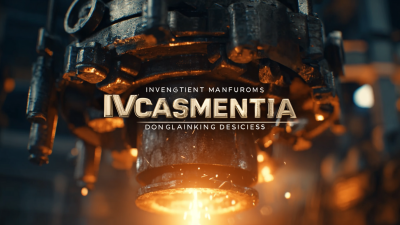In the ever-evolving landscape of manufacturing, the role of Investment Casting Supplies has gained unprecedented significance. Recent industry studies reveal that the investment casting market is projected to reach a staggering USD 28.16 billion by 2027, growing at a CAGR of 5.4% from 2020 to 2027. This rapid growth underscores the need for streamlined processes and optimized resource allocation within the supply chain. Effective management of investment casting supplies not only enhances production efficiency but also reduces overhead costs, a necessity highlighted by a report from Grand View Research indicating that operational inefficiencies can account for up to 30% of production costs in the casting industry. As companies strive to improve their competitive edge, leveraging insights from these studies can pave the way for innovative approaches tailored to maximize the effectiveness of their investment casting supplies, ultimately leading to improved product quality and satisfying market demand.

Streamlining material procurement in investment casting is essential for enhancing overall operational efficiency. Recent industry studies highlight the importance of establishing strong relationships with suppliers, which can lead to reduced lead times and optimized inventory levels. By implementing a vendor management system, companies can systematically track supplier performance, facilitating more informed decision-making and ensuring that high-quality materials are always available when needed.
Additionally, adopting just-in-time (JIT) inventory practices can significantly minimize waste and lower carrying costs. This approach requires careful forecasting and collaboration with suppliers to ensure materials arrive precisely when required for production. Investing in technology, such as automated procurement software, can further enhance coordination between procurement and production teams, enabling a more agile response to fluctuating demand.
By focusing on these strategies, investment casting businesses can not only streamline their material procurement processes but also contribute to overall cost efficiency and improved product quality in a competitive market.
Recent industry studies have highlighted the significant impact of advanced technologies on the efficiency of supply chains within the investment casting sector. For instance, the use of automation and robotics has been shown to reduce lead times by up to 30%. According to a report by the Casting Industry Research Institute, companies that have integrated smart manufacturing technologies into their operations report a marked increase in productivity, with some facilities achieving up to a 25% reduction in operational costs. This shift not only streamlines production processes but also enhances flexibility in responding to market demands.
Moreover, the implementation of predictive analytics in inventory management has transformed how supply chains operate in investment casting. By utilizing data-driven insights, firms are able to anticipate demand fluctuations with greater accuracy. A study conducted by the American Foundry Society revealed that investment casting companies employing predictive analytics experienced a 20% reduction in excess inventory costs. This newfound agility enables manufacturers to maintain optimal stock levels while minimizing waste, further contributing to overall supply chain efficiency. The integration of these advanced technologies marks a critical evolution in the investment casting industry, fostering a more responsive and cost-effective supply chain model.
The food logistics industry faces significant challenges in combating rising costs and supply chain disruptions. Recent surveys, including those conducted by Deloitte, reveal that companies are struggling with geopolitical and security threats, scoring a mere 3.7 out of 10 in confidence levels. To navigate these turbulent waters, businesses must adopt strategic cost reduction techniques.
Tips: One effective method is to enhance inventory management through advanced data analytics. This ensures that businesses maintain optimal stock levels while minimizing waste. Additionally, leveraging predictive analytics can help forecast demand accurately, allowing companies to adjust their supply chains proactively.
Moreover, AI technology is emerging as a crucial tool for businesses in various sectors, including retail and food logistics. A recent study indicates that 90% of retailers are either using or piloting AI, which can streamline operations and reduce costs. Integrating AI-driven solutions can offer insights into consumer behavior, optimize delivery routes, and enhance overall efficiency.
Tips: Implementing AI tools can lead to significant savings by automating repetitive tasks and improving decision-making processes. Companies are encouraged to explore affordable AI models that are becoming available, as these can drive a substantial increase in operational effectiveness.
Supplier relationships play a crucial role in enhancing the performance of investment casting operations. According to a recent report from the Investment Casting Institute, companies that prioritize strong partnerships with their suppliers see a 15% increase in production efficiency and a notable reduction in material costs. Collaborative relationships allow for better communication, timely delivery of high-quality materials, and access to the latest technological advancements, enabling companies to stay competitive in the ever-evolving marketplace.
To maximize the benefits of these supplier relationships, companies should focus on three key strategies. First, establishing regular communication channels can prevent misunderstandings and facilitate quicker problem resolution. Second, engaging suppliers in the design process can lead to innovative solutions that enhance casting quality. Lastly, consider forming long-term contracts that foster loyalty and encourage suppliers to invest in better technologies tailored to your specific needs.
Tips for Building Strong Supplier Relationships:
In recent years, the investment casting industry has made significant strides toward minimizing waste in the supply chain. Recent studies highlight several best practices that can be benchmarked to enhance efficiency and sustainability. For instance, adopting a closed-loop system for material recovery not only reduces scrap but also lowers production costs by reintroducing excess materials back into the production cycle. Companies are increasingly implementing sophisticated inventory management systems, allowing for real-time tracking of materials. This precision ensures that excess supplies are kept to a minimum, effectively reducing waste and enhancing operational efficiency.
Additionally, collaboration with suppliers plays a crucial role in waste minimization. Engaging in strategic partnerships can lead to shared resources and insights, which help identify areas for improvement in the supply chain. Industry leaders are also exploring innovative technologies such as additive manufacturing to optimize mold design, leading to more efficient use of materials. By benchmarking these best practices, companies can develop comprehensive strategies that not only reduce waste but also promote a more sustainable approach to investment casting.






